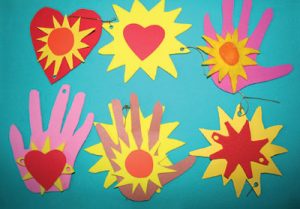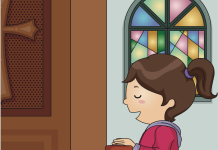
A Triangle Approach to Learning and Life
JEANNE HEIBERG
When teachers I recruited and trained in an upstate New York district gave me a pendant made up of many triangles, I knew they got my message. I had frequently spoken of a “triangle” approach to religious education that reached the whole child: mind, heart, and hands. The triangle pendant was presented with laughter and teasing as we recalled our first class together.
Theory and Practice
I started that class by drawing an equilateral triangle on the board. At the top tip, I drew a sun to represent the mind—the intelligence of the children we want to reach. Of equal importance is the heart, which I drew on the left-hand tip of the triangle. This stands for feelings, imagination, and creative enthusiasm of the children we want to inspire. On the right-hand tip of the triangle, I drew a hand, to represent the senses of the children, their need for activity, for learning how to put into action what they learn in religion class.
Although these practices developed largely after the Second Vatican Council, they relate back to an older tradition. The nineteenth-century Baltimore Catechism asked, “Why did God make me?” the answer was, “God made me to know, love, and serve him.” There you are—the three points of the triangle: head, heart, and hand, given in faith theory if not yet in catechetical practice. Our knowledge of how children learn, develop, and retain faith learning has grown considerably since then.
These three parts of us—knowing, loving, and serving—are three ways we are made in the image of God. They are three ways God wants to be expressed in and through us. The number three is important. The triangle, with its three points, is the strongest building structure. It is also a symbol of the Trinity: Father, Son, and Holy Spirit.
Minding Our Minds
In the Hebrew Scriptures, there was no separate category for the mind; the seat of intelligence was thought to be in the heart and it covered all that was inside of a person. The heart contained thoughts, ideas, memories, decisions, plans, and choices. The Book of Sirach says that God forms people’s eyes and ears (the senses), gives them understanding hearts, and fills them with wisdom and knowledge (17:5-6).
Through Isaiah, Jesus speaks of God creating people with eyes to see so that they may believe and understand (John 12:37-40). Further mind functions are indicated when Jesus says you can cast mountains into the sea, but only when you truly believe.
Saint Paul urges Christians to mind their minds with these beautiful lines: “Whatever things are true, whatever honorable, whatever just, whatever holy, whatever lovable, whatever of good repute, if there be any virtue, if anything worthy of praise, think upon these things” (Philippians 4:8) and “Let this mind be in you, which was in Christ Jesus” (Philippians 2:5). Paul speaks of our true mind, one with Jesus and our loving Creator. Jesus came to bring us back to what we were created for—to share in the mind and heart of God. When we do this, we are following St. Paul’s instruction to be transformed and renewed in “the spirit of your mind” (Ephesians 4:23; also see Romans 12:2).
We want to do all we can to learn about God’s beautiful creation, especially the perfect creation of the human being. This means that we need to “mind our minds,” to think and act from the true mind that God created in us, our Christ mind, the part of us that reflects the very image of God.
When we mind our minds, we learn more about who we really are and what we are here to do. For example, when we think mean, hateful, and selfish thoughts or hold resentments, envies, and grudges, we are being misguided. However, when we think loving, kind, and creative thoughts, our true minds, our Christ minds, are at work. Our thoughts more easily flow into warm, happy feelings and kind, loving actions. St. Paul tells us that the “concern of the Spirit is life and peace” (Romans 8:6).
We need help in keeping our minds connected to God. Jesus came to make this possible. He said, “I and the Father are one” (John 10:30). He is the way for us to be one with God.
We all struggle with negative thoughts and feelings, distractions, and critical conversations in our heads. However, prayer, minding our minds, and seeing what is good and beautiful in others and in all of life bring rich rewards.
Loving with Heart
The law of love appears early in the Old Testament. “Take no revenge and cherish no grudge” but rather “love your neighbor as yourself” (Leviticus 19:18).
In the New Testament, Jesus says “You shall love the Lord, your God, with all your heart, with all your soul, and with all your mind. This is the greatest and the first commandment. The second is like it: You shall love your neighbor as yourself (Matthew 22:37-39).
Paul says that love is the only debt that we have to one another (Romans 13:8, 10). He prays that Christ dwell in our hearts through faith and that charity be the root and foundation of our lives (Ephesians 3:14-21). He advises us to get rid of all bitterness, passion, anger, harsh words, slander, malice, and other thoughts that separate us from God. In place of these, he urges kindness, compassion, and forgiveness (Ephesians 4:31-32).
This is possible because the Spirit of Jesus is sent into our hearts (Galatians 4:6). Jesus came to bring us back into the oneness of that love and prayed that “The love with which you have loved me may be in them, and I in them” (John 17:11, 20-21).
We are created to love as God loves. We are created by God’s love, to share in God’s love, and to express God’s love to others. God wants to love in and through us. Such love expresses itself in joy and in actions and service, the third point of the triangle.
Senses and Service
Although God created our senses, we cannot directly experience God through these physical gifts. We have these gifts to make our way in a physical world, to praise God, and to help and serve one another.
Jesus taught through concrete, sensory things that people saw around them: sheep, goats, lost coins, dough with yeast, seeds, and fig trees. He gave us Sacraments so that visible things we see, taste, and touch reveal to us the presence of God. Bread, wine, oil, water, and fire bring us into communion so that we know and feel God’s presence. Through the Sacraments, we know that Jesus, unseen by physical eyes, is touching us in a deep and wonderful way.
Sacraments—that we celebrate with our senses—help us make good use of our senses in service to others. Jesus teaches us about this: “For the Son of Man did not come to be served but to serve” (Mark 10:45; also see John 13:15f). Jesus says, “I am among you as one who serves” (Luke 22:27).
We don’t always think of God, Creator of the Universe, as one who serves us. But Jesus, who most perfectly expressed the image of God, came as a servant. He washed the feet of his disciples like the most humble servant. He said that those who serve and care for others are welcome in the kingdom of heaven, where we are restored in the image of God.
Say to the Children
God has given each of us a mind, a heart, and senses to learn about God, to praise God, and to serve God and others. We are meant to develop and use all these gifts and to grow to be our best and greatest selves and to give our Creator wholehearted praise by serving and caring for others.
The first book of the Bible tells us that we are made in God’s image. We can’t see God with our physical eyes, but only with the inner eyes of our mind and heart. God generously shared with us his very being—his mind and heart. When humans separated from God, Jesus came to return us to God and to restore our minds and hearts to be in the image of God.
Jesus helps us reconnect with God so that we are part of God’s wonderful mind and heart and are able to grow in God’s ways of thinking, loving, and serving. (Share parts of the previous text and Scripture references with your students, according to their ability to understand.)
Reconnected to God through Jesus, we grow in our ability to express God’s wisdom and love. Our minds and hearts and hands are needed to express God’s wisdom and love in the world.
This means that when we come to class and at Mass and in every day of our lives, we use our ears to listen carefully, we use our eyes to see the goodness and beauty in creation and in people, we use our voices to sing out God’s praise, and we use our hands to help and serve others.
The craft below will help students make symbols that remind them to use their minds, hearts, and hands to live their faith.
ACTIVITY: Head, Heart, and Hand Craft
 MATERIALS
MATERIALS
* construction paper or foam craft sheets in a wide variety of colors including red, yellow, pink, brown, white, black, and orange
* scissors
* hole puncher
* cord
* glue
* branches, sticks, or dowels on which to hang symbols
* patterns (CLICK HERE)
PROCEDURE
1. Copy the patterns provided (adjust size as preferred) or have students make their own sunburst, heart, and hand patterns. (Have students make hand patterns from their own hands; this allows them to have greater personal expression in the craft activity.)
2. Cut out patterns.
3. Trace patterns on different colors of construction paper or foam craft sheets.
4. Layer the pieces (or use singly) in any combination (circles in sunbursts; hearts in hands; hearts in sunbursts in hands; etc.) and glue together.
5. Punch holes in the top and bottom of each completed symbol and attach them one above the other with cord.
6. Attach the end of the cord to a branch, stick, or dowel to make a mobile.
(You may want students to make their own mobiles or work in groups or as a class to make a common mobile. Nine to fifteen symbols make for a full mobile. Arrange symbols so that similar colors and symbols are spaced out for variety. For more information about how to arrange your mobile, go to enchantedlearning.com/crafts/mobiles.)
Suspend mobile(s) near the prayer table (or make mobile(s) your prayer focus). Mobiles are colorful, cheerful classroom decorations. Let students take home a symbol or mobile to remind them and their families that they are created in God’s image to know, love, and serve God and others and to joyfully praise God with all they have and are.
Praising-God-with-All-of-Me Prayer
On or above your prayer table, place the students’ completed crafts and a Bible. Put bookmarks in the Bible at the readings you choose to use (see Readings).
Leader: Thank you, Lord, for your gift of life on this earth—in a wonderful body that can do so much; with a mind that can learn, think, and know; with a heart that can love, feel, remember, imagine, and create.
All: Amen.
Readings: Philippians 4:8 (think on what is true, honorable, just, pure, lovely, gracious); Leviticus 19:18 (love your neighbor as yourself); Matthew 22:37-39 (the Two Great Commandments); Luke 22:27 (Jesus speaks of service)
Leader: Our minds, hearts, and hands are wonderful gifts from God given to us so that we might know, love, and serve God and our fellow human beings. Let us now praise and thank God with these gifts that we have been given.
(Place your hands around your head.) We lift our wonderful minds to you, God. Help us to remember you are always with us. You want to light up our minds with wonderful truths and ideas that will help us in all our decisions and choices. You, Loving Creator God, want to shine through us to others and to the world.
(Place your hands over your hearts.) Loving Creator, bless our hearts to help us remember that you created us in love to love as you do, unconditionally, without fear, without judgment, and beyond narrow self-interests. We know in this limited world we must use good judgment, practice safety, and observe good common sense. May our hearts offer your love to others through our work, study, creativity, and play.
(Hold out your hands.) Lord, bless these hands to remind us that we are made to express your love to others through all our senses and to serve you and others through our gifts and talents.
Let us go now in peace to know, love, and serve our loving Creator with minds, hearts, and hands, with Jesus, in the power of the Holy Spirit.
All: Amen.
Closing Song: “Praise God from Whom All Blessings Flow” (“Old Hundredth”). Text: verse 1, Thomas Kent, 1637-1711; verses 2, 3, Isaac Watts, 1674-1748. Music: German psalter, 1551, attributed to Louis Bourgeois, 1510-1561. Found in Breaking Bread, OCP (ocp.org)
Jeanne Heiberg is the author of Advent Arts & Christmas Crafts (Paulist Press) and Advent calendars (Creative Communications). She has taught art, writing, creative catechetics, and meditation, and has directed parish catechetical programs. Jeanne writes, paints, and gives writing workshops in upstate New York. Jeanne welcomes visitors at her blog: jeannesarts4you.blogspot.com.
This article was originally published in Catechist magazine, February 2010.
Photo: Anna Kolosyuk on Unsplash




